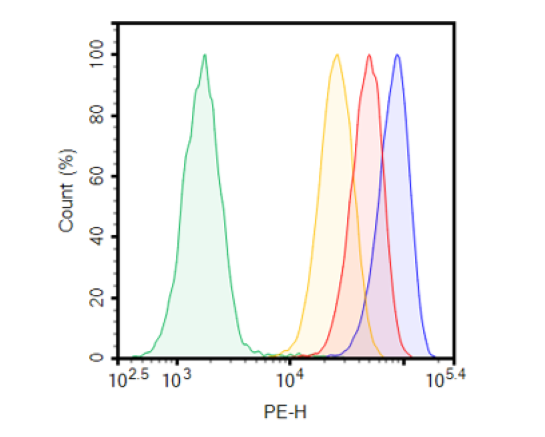NKp46 CHO Cell Line (High, Medium, or Low Expression)
NKp46 CHO Cell Line is a clonal CHO cell line stably expressing full-length human NKp46 (Natural cytotoxicity triggering receptor 1) (NM_004829). Surface expression of NKp46 was confirmed by flow cytometry. Stable clonal cell lines were selected for different levels of NKp46 expression (low, medium, and high) compared to the parental CHO-K1 cell line.
Purchase of this cell line is for research purposes only; commercial use requires a separate license. View the full terms and conditions.
| Name | Ordering Information |
| Thaw Medium 3 | BPS Bioscience #60186 |
| Growth Medium 3J | BPS Bioscience #79974 |
The cell line has been screened to confirm the absence of Mycoplasma species.
NKp46 (also known as Natural cytotoxicity triggering receptor 1, or NCR1) is an important natural killer (NK) cell-activating receptor expressed on the surface of human NK cells, and it is involved in cytotoxicity. NKp46 participates in the activation of NK cells against pathogens, tumor cells, and virally infected cells. It also plays an important role in autoimmune conditions, including type I diabetes. NKp46 expression is often conserved on infiltrating NK cells in most solid tumors, and NKp46 is a diagnostic biomarker and possible therapeutic target for gastrointestinal T-cell lymphoproliferative diseases. Although a few infectious NKp46 ligands have been identified, endogenous NKp46 cell surface ligands are unknown. Recently, it was reported that NKp46 binds to externalized calreticulin (ecto-CRT), which translocate from the ER (endoplasmic reticulum) to the plasma membrane in situations of cellular stress such as chemotherapy and senescence. This leads to NK cell degranulation and target cell killing and can participate in controlling cancer. Further studies will elucidate the exact mechanism and roles of NKp46 and its ligands in disease and allow the development of new therapeutics for cancer therapy.
Sivori S., et al., 1999 Eur J Immunol. 29 (5):1656-66.
Gardner G. and Fraker C.A., 2021 Front Immunol. 12:722979.
Sen Santara S., et al., 2023 Nature 616 (7956):348-356.


